An interview with Jaouher Selmi from RENAULT. Renault Group, originally from France, is a leading company in the production of cars, including commercial vehicles and racing cars. As a project partner, RENAULT will implement and test Twin-Control’s results.
How did you know about the project? What aspects of the project attracted you to join it?
Renault was investigating and looking for a partnership in order to develop the use of the prediction of the machine behaviour in machining until finding out the Twin-Control project proposal.
How is work carried out at the production plants on a daily basis?
Regarding maintenance, when the machine breaks down, production is stopped until the repair intervention is made. This has an impact on the production capacity. Regarding part quality, when a quality deviation happens production is stopped until the investigation is conducted and the process adjustment are made.
How will Twin-Control improve production?
Regarding maintenance, Twin-Control will help to avoid/reduce unexpected breakdowns, and to get a better organization of maintenance human resources in order to give priority to the machine at risk before it breaks down, and also allowing to make the different interventions during maintenance programmed time.
Regarding part quality, Twin-Control will detect the machining behaviour deviation and help to make the adjustment as soon as possible, before having big issues on part quality.
For which processes will Twin-Control be used?
Twin-Control can be used for the most common machining processes (boring, milling and drilling). For Renault the most critical machining operation is boring, and that is why using Twin-Control will have an interesting enhancement on our production.
How do you see the future of machine tool simulation?
Machine tool simulation will help both machine supplier and end users to better design their machine and their processes in the future. It will also give the opportunity to reduce design costs, increase production effectiveness and enhance their parts’ quality. This is the future of machining.

